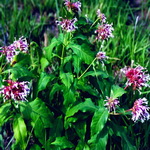| Common Name: |
Sarpaganda |
| Other Names: |
Chandra, Rauwolfia, Indian Snakeroot, Serpentwood, Snakeroot |
| Botanical Name: |
Rauvolfia serpentina |
| Genus: |
Rauvolfia |
| Family: |
Apocynaceae |
| Native Location: |
India, Sri Lanka, Burma (Myanmar), Andaman Islands, and Java |
| Cultivation: |
Well-drained soil in sun or partial shade, with an almost dry winter resting period. |
| Propagation: |
By seed sown at 24°C (75°F) in spring; by stem cuttings in spring and summer; by root cuttings in winter. Seeds have a low germination rate. |
| Harvest: |
Roots 1cm (½in) in diameter are lifted in winter, from plants at least 15 months old, and dried for use in decoctions and powders, or for commercial extraction of alkaloids. Bark and inner root may be separated before drying. |
| Height: |
30-60cm (1-2ft) |
| Width: |
30-60cm (1-2ft) |
| Hardiness: |
Min. 10-13°C (50-55°F) |
| Parts Used: |
Roots |
| Chemical Constituents: |
Ajmaline
Deserpidine
Rescinnamine
Reserpine
Serpentine
Yohimbine
|
| Properties: |
A tranquilizing, sedative herb that lowers blood pressure and slows heart beat. |
| Known Effects: |
Reduces blood pressure
Depresses activity of central nervous system
Hypnotic
Miscellaneous Information:
Snakeroot depletes catecholamines and serotonin from nerves in the central nervous system.
Refined snakeroot has been used extensively in recent years to treat hypertension.
Animal studies suggest snakeroot may produce cancers.
|
| Possible Additional Effects: |
May decrease anxiety
May decrease fever
May kill intestinal parasites
In India, used as antidote for snakebites
|
| Medicinal Uses: |
Internally for mild hypertension, rapid heartbeat, and nervous and mental disorders. In Folk medicine, internally for fever, cholera, high blood pressure, snakebite, intestinal worms, and to increase contractions in childbirth; externally for eye problems. |
| Warnings and Precautions: |
Contraindicated during pregnancy and lactation, and in depression. Side-effects include dry mouth, nasal congestion, depression, fatigue, and slowed heartbeat. Interacts with a number of prescription drugs, including Digitalis glycosides, barbiturates, cough and cold medications, and appetite suppressants.
This herb is subject to legal restrictions in some countries.
Don't take if you:
Are pregnant, think you may be pregnant or plan pregnancy in the near future
Have any chronic disease of the gastrointestinal tract, such as stomach or duodenal ulcers, reflux esophagitis, ulcerative colitis, spastic colitis, diverticulitis or diverticulitis
Consult your doctor if you:
Take this herb for any medical problem that doesn't improve in 2 weeks (There may be safer, more effective treatments.)
Take any medicinal drugs or herbs including aspirin, laxatives, cold and cough remedies, antacids, vitamins, minerals, amino acids, supplements, other prescription or non-prescription drugs
Pregnancy:
Dangers outweigh any possible benefits. Don't use.
Breastfeeding:
Dangers outweigh any possible benefits. Don't use.
Infants and Children:
Treating infants and children under 2 with any herbal preparation is hazardous
Others:
Dangers outweigh any possible benefits. Don't use.
Storage:
Store in cool, dry area away from direct light, but don't freeze.
Store safely out of reach of children.
Don't store in bathroom medicine cabinet. Heat and moisture may change the action of the herb.
Safe Dosage:
At present no "safe" dosage has been established.
|
| Toxicity: |
Rated slightly dangerous, particularly in children, persons over 55 and those who take larger than appropriate quantities for extended periods of time. |
| Adverse Reactions, Side Effects, or Overdose Symptoms: |
| Signs and Symptoms |
What to Do |
|
| Bizarre dreams |
Discontinue. Call doctor when convenient. |
| Decreased libido and sexual performance |
Discontinue. Call doctor when convenient. |
| Diarrhea |
Discontinue. Call doctor immediately. |
| Drowsiness |
Discontinue. Call doctor when convenient. |
| Nasal congestion |
Discontinue. Call doctor when convenient. |
| Precipitous blood-pressure drop; symptoms include faintness, cold sweat, paleness, rapid pulse |
Seek emergency treatment |
| Slow heartbeat |
Seek emergency treatment |
| Stupor |
Seek emergency treatment |
| Upper abdominal pain |
Discontinue. Call doctor when convenient. |
|
| Bibliography: |
Encyclopedia of herbs by Deni Brown Copyright © 1995, 2001 Dorling Kindersley Limited. pg 341
Vitamins, Herbs, Minerals & Supplements The Complete Guide by H. Winter Griffith, MD Copyright©1998 Fisher Books. pp. 424-425 |

